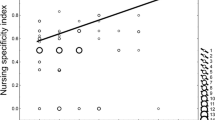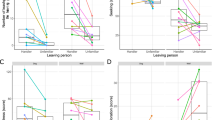Abstract
Parental care is an essential component in the life history of mammals. In group-living species, care can be provided by adults other than the parents, and such care is termed alloparental care. Alloparental care is known in a wide spectrum of species, from insects to humans. Most canids that live in stable packs demonstrate cooperative breeding, where subordinates provide care to the offspring of the dominants, without reproducing themselves. Free-ranging dogs in India have a dynamic social system and, unlike their cooperatively breeding ancestors, the grey wolves, all adults in a dog group have equal mating opportunities. This at times leads to the birth of multiple litters within an existing dog group. In this paper, we report the first field observations of alloparental care made on a dog group where a bitch provided care to her grandpups, through interactions other than suckling. The allomaternal care acted as a supplement to the care provided by the mother, and was thus beneficial to the pups.




Similar content being viewed by others
References
Achappa A (2012) Stray dog chasing black buck. Conservation India Gallery July 27. http://www.conservationindia.org/gallery/stray-dog-chasing-blackbucks
Allen D (1979) Wolves of Minong: Isle Royale’s wild community. University of Michigan Press, Ann Arbor
Allen W (1986) Pseudopregnancy in the bitch: the current view on aetiology and treatment. J Small Anim Pract 27:419–424
Bastan A, Findik M, Aslan S (1998) The use of cabergoline for treatment of pseudopregnancy in dogs with the purpose of suppressing lactation. Reprod Dom Anim 33:49–53
Beck A (1975) The ecology of “feral” and free-roving dogs in Baltimore. In: Fox MW (ed) The wild canids: their systematics, behavioral ecology and evolution. Van Nostrand Reinhold, Florence, pp 380–390
Bekoff M (1975) Social behavior and ecology of the African Canidae: a review. In: Fox MW (ed) The wild canids: their systematics, behavioral ecology and evolution. Van Nostrand Reinhold, Florence, pp 120–142
Bekoff M (1977) Canis latrans. Mamm Species 79:1–9
Bekoff M, Wells M (1980) The social ecology of coyotes. Sci Am 242:130–148
Berman M, Dunbar I (1983) The social behaviour of free-ranging suburban dogs. Appl Anim Ethol 10:5–17
Clutton-Brock T (1991) The evolution of parental care. Princeton University Press, New Jersey
Clutton-Brock J (1995) Origins of the dog: domestication and early history. In: Serpell J (ed) The domestic dog, its evolution, behaviour and interactions with people. Cambridge University Press, Cambridge, pp 7–20
Clutton-Brock TH (2006) Cooperative breeding in mammals. In: Kappeler PM, Schaik CP (eds) Cooperation in primates and humans. Springer, Berlin, pp 173–190. doi:10.1007/3-540-28277-7_10
Cornwallis CK, West SA, Davis KE, Griffin AS (2010) Promiscuity and the evolutionary transition to complex societies. Nature 466:969–972. doi:10.1038/nature09335
Creel S, Macdonald D (1995) Sociality, group size, and reproductive suppression among carnivores. Adv Study Behav 24:203–257
Daniels T (1983) The social organization of free-ranging urban dogs. I. Non-estrous social behavior. Appl Anim Ethol 10:341–363
Dewey K (1997) Energy and protein requirements during lactation. Annu Rev Nutr 17:19–36
Dewey K (1998) Effects of maternal caloric restriction and exercise during lactation. J Nutr 128:386S–389S
Emlen ST (1982) The evolution of helping. I. An ecological constraints model. Am Nat 119:29–39
Estes R, Goddard J (1967) Prey selection and hunting behavior of the African wild dog. J Wildl Manag 31(1):52–70
Ewer R (1973) The carnivores. Cornell University Press, USA
Font E (1987) Spacing and social organization: urban stray dogs revisited. Appl Anim Behav Sci 17:319–328
Fox M (1975) Evolution of social behavior in canids. In: Fox MW (ed) The wild canids: their systematics, behavioral ecology and evolution. Van Nostrand Reinhold, Florence, pp 429–460
Fox M, Beck A, Blackman E (1975) Behavior and ecology of a small group of urban dogs (Canis familiaris). Appl Anim Ethol 1:119–137
Gier H (1975) Ecology and behavior of the coyote (Canis latrans). In: Fox MW (ed) The wild canids: their systematics, behavioral ecology and evolution. Van Nostrand Reinhold, Florence, pp 247–262
Gobello C, Baschar H, Castex G, de la Sota RL, Goya RG (2001a) Dioestrous ovariectomy: a model to study the role of progesterone in the onset of canine pseudopregnancy. J Reprod Fertil 57:55–60
Gobello C, Concannon PW, Iii JV (2001b) Canine pseudopregnancy: a review. In: Concannon PW, England G, Verstegen III J, Linde-Forsberg C (eds) Recent advances in small animal reproduction. International Veterinary Information Service, Ithaca, NY, A1215.0801
Gubernick DJ (1981) Parent and infant attachment in mammals. In: Gubernick DJ, Klopfer PH (eds) Parental care in mammals. Springer, New York, pp 243–305
Hamilton W (1964) The genetical evolution of social behaviour. II. J Theor Biol 7:17–52
Jennions M, Macdonald D (1994) Cooperative breeding in mammals. Trends Ecol Evol 9:89–93
Johnson C, Angeles L (1980) Alloparental care and kinship in captive social groups of vervet monkeys (Cercopithecus aethiops sabaeus). Primates 21:406–415
Jones CB (1981) Comment on “Allomothering Langurs” in Hanuman. Ethol Sociobiol 2:89–90
Kaushik A (2008) Dogs hunt black bucks at Velavadar sanctuary. The Times of India, September 17
Kleiman D (1968) Reproduction in the Canidae. Int Zoo Yearb 8:3–8
Kleiman DG (2011) Canid mating systems, social behavior, parental care and ontogeny: are they flexible? Behav Genet 41:803–809. doi:10.1007/s10519-011-9459-0
Kleiman D, Brady C (1978) Coyote behavior in the context of recent canid research. In: Bekoff M (ed) Coyotes: biology, behaviour and management. Academic, New York, pp 163–188
Kleiman D, Malcolm J (1981) The evolution of male parental investment in mammals. In: Gubernick DJ, Klopfer PH (eds) Parental care in mammals. Springer, New York, pp 347–387
Kruuk H (1975) Functional aspects of social hunting by carnivores. In: Baerends G, Beer C, Manning A (eds) Functions and evolution in behaviour: essays in honour of Professor Niko Tinbergen. Oxford University Press, Oxford
Kühme W (1965) Communal food distribution and division of labour in African hunting dogs. Nature 205:443
Lukas D, Clutton-Brock T (2012) Cooperative breeding and monogamy in mammalian societies. Proc R Soc Lond B 279:2151–2156. doi:10.1098/rspb.2011.2468
Macdonald D (1979) The flexible social system of the golden jackal, Canis aureus. Behav Ecol Sociobiol 5:17–38
Macdonald D (1983) The ecology of carnivore social behaviour. Nature 301:379–384
Md-Zain BMCEC, Ch’ng CE (2011) The activity patterns of a group of Cantor’s dusky leaf monkeys (Trachypithecus obscurus halonifer). Int J Zool Res 7:59–67
Mech LD (1970) The wolf: ecology and behavior of an endangered species. Natural History Press, Garden City
Moehlman PD (1979) Jackal helpers and pup survival. Nature 277:382–383
Moehlman P, Hofer H (1997) Cooperative breeding, reproductive suppression, and body mass in canids. In: Moehlman PD, Hofer H, Solomon NG (eds) Cooperative breeding in mammals. Cambridge University Press, Cambridge, pp 76–128
Montgomerie R (1981) Why do jackals help their parents? Nature 289:824–825
Morris C (2011) Exploring the necessity of others in human evolution. J Soc Evol Cult Psychol 5(4):293–295
Murie A (1985) The wolves of Mount McKinley. University of Washington Press, Seattle
Oppili P (2013) Birds fall prey to dogs at Pallikaranai. The Hindu, October 29
Pal SK (2005) Parental care in free-ranging dogs, Canis familiaris. Appl Anim Behav Sci 90:31–47. doi:10.1016/j.applanim.2004.08.002
Pal S (2008) Maturation and development of social behaviour during early ontogeny in free-ranging dog puppies in West Bengal, India. Appl Anim Behav Sci 111:95–107. doi:10.1016/j.applanim.2007.05.016
Pal SK (2011) Mating system of free-ranging dogs (Canis familiaris). Int J Zool 2011:1–10. doi:10.1155/2011/314216
Pal S, Ghosh B, Roy S (1998) Dispersal behaviour of free-ranging dogs (Canis familiaris) in relation to age, sex, season and dispersal distance. Appl Anim Behav Sci 61:123–132
Peterson R, Ciucci P (2003) The wolf as a carnivore. In: Mech LD, Boitani L (eds) Wolves: behavior, ecology, and conservation. University of Chicago Press, Chicago, pp 104–130
Quinlan RJ, Quinlan MB (2008) Human lactation, pair-bonds, and alloparents. Hum Nat 19:87–102. doi:10.1007/s12110-007-9026-9
Redondo T, Tortosa FS, Reyna LA (1995) Nest switching and alloparental care in colonial white storks. Anim Behav 49:1097–1110
Rheingold H (1963) Maternal behavior in mammals. Wiley, New York
Riedman ML (1982) The evolution of alloparental care and adoption in mammals and birds. Q Rev Biol 57:405–435
Rogowitz G (1996) Trade-offs in energy allocation during lactation. Am Zool 36:197–204
Rohwer S, Herron J, Daly M (1999) Stepparental behavior as mating effort in birds and other animals. Evol Hum Behav 20:367–390
Sandell M (1989) The mating tactics and spacing patterns of solitary carnivores. In: Gittleman JL (ed) Carnivore behaviour, ecology and evolution, vol I. Cornell University Press, Ithaca, pp 164–182
Scott J, Fuller J (1965) Genetics and the social behavior of the dog. University of Chicago Press, Chicago
Scott J, Marston M (1950) Critical periods affecting the development of normal and mal-adjustive social behavior of puppies. Pedagog Semin J Genet Psychol 77:25–60
Sen Majumder S, Bhadra A, Ghosh A et al. (2013/2014) To be or not to be social: foraging associations of free-ranging dogs in an urban ecosystem. Acta Ethol 17(1):1–8. doi:10.1007/s10211-013-0158-0
Serpell J (1995) The domestic dog: its evolution, behaviour and interactions with people. Cambridge University Press, Cambridge
Sillero-Zubiri C, Hoffmann M, Macdonald DW (2004) Canids: foxes, wolves, jackals, and dogs: status survey and conservation action plan. Information Press, Oxford
Small MF (1990) Alloparental behaviour in Barbary macaques, Macaca sylvanus. Anim Behav 39:297–306
Solomon N, French J (1997) Cooperative breeding in mammals. Cambridge University Press, Cambridge
van Lawick H, van Lawick-Goodall J (1971) Innocent killers. Houghton Mifflin, Boston
Vanak A, Gompper M (2009) Dietary niche separation between sympatric free-ranging domestic dogs and Indian foxes in central India. J Mamm 90:1058–1065
Vanak AT, Thaker M, Gompper ME (2009) Experimental examination of behavioural interactions between free-ranging wild and domestic canids. Behav Ecol Sociobiol 64:279–287. doi:10.1007/s00265-009-0845-z
Weber AF (1944) Pseudopregnancy in dogs. Iowa State University Vet 7(1):32–38
Welker W (1959) Genesis of exploratory and play behavior in infant raccoons. Psychol Rep 5(3):764
Wilson EO (1975) Leptothorax duloticus and the beginnings of slavery in ants. Evolution 29(1):108–119
Wisenden B (1999) Alloparental care in fishes. Rev Fish Biol Fish 9:45–70
Woodroffe R, Vincent A (1994) Mother’s little helpers: patterns of male care in mammals. Trends Ecol Evol 9:294–297
Acknowledgments
This work was purely observation based, and was carried out on the IISER-K campus, without harming the dogs in any manner, or handling them, and did not violate the animal rights and ethics laws of India. M.P. and S.S.M. carried out the observations. A.B. planned and supervised the work. M.P. co-wrote the paper with A.B. The authors thank the Council for Scientific and Industrial Research, India for funding and the Indian Institute of Science Education and Research—Kolkata, India for providing infrastructural support. We thank the members of the MTS unit, IISER-Kolkata for allowing free access of their terrace to ML and her family. We thank Prof. Raghavendra Gadagkar of the Indian Institute of Science, Bangalore and Jan Koler-Matznick, CPDT, USA for their inputs that helped to improve this manuscript.
Author information
Authors and Affiliations
Corresponding author
Electronic supplementary material
Below is the link to the electronic supplementary material.
10164_2014_396_MOESM2_ESM.tif
ESM Figure 1: The LEL and MTS buildings with the denning sites of ML and PW marked with arrows on the two terraces. (TIFF 56691 kb)
10164_2014_396_MOESM3_ESM.tif
ESM Figure 2: Detailed map of the area under observation, showing the home range of the focal group (marked with yellow) and all the resources and landmarks within the area. Geographical coordinates were measured using a Garmin eTrex 30 GPS device. The positional data was compiled using ‘Garmin Basecamp’ and the territory was delineated on Google Earth. (TIFF 1389 kb)
About this article
Cite this article
Paul, M., Majumder, S.S. & Bhadra, A. Grandmotherly care: a case study in Indian free-ranging dogs. J Ethol 32, 75–82 (2014). https://doi.org/10.1007/s10164-014-0396-2
Received:
Accepted:
Published:
Issue Date:
DOI: https://doi.org/10.1007/s10164-014-0396-2




